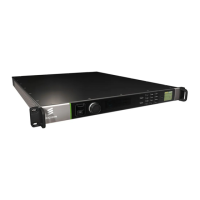Figure 3.82 Alarm Monitoring
3.18 Simple Network Management Protocol
Simple Network Management Protocol (SNMP) is an application layer protocol that
facilitates the exchange of management information between network devices. It is
part of the Transmission Control Protocol/Internet Protocol (TCP/IP) protocol suite
and is defined in a set of standards (RFC 1065 - RFC 1067, RFC 1155 - RFC 1157,
RFC 1213, RFC 1441 - RFC 1452, RFC 1901 - RFC 1910, RFC 2576, RFC 3411 -
RFC 3418) published by the Internet Engineering Task Force (IETF).
3.18.1 Supported Protocols
SNMP versions 1, 2c are supported, primarily for alarm trap handling. The General
Ericsson Television MIB is also supported.
Note: The unit does not support control via SNMP, all remote control is via HTTP.
3.18.2 Operation
SNMP traps are a way of reporting status information to a control system. The unit’s
SNMP functionality can be enabled or disabled, with up to five IP addresses
assigned for any SNMP Trap message to be sent. The default is 000.000.000.000,
which causes the SNMP traps to be sent to the last SNMP master. The SNMP
community name can also be set.
The user can control which SNMP traps are generated. The options are:
• All traps – traps sent for all failure alarms, warnings and start messages.
• Start Msgs, warning – critical – traps sent for start messages or alarms raised
of severity warning to critical.
• Start Msgs, minor – critical – traps sent for start messages or alarms raised of
severity minor to critical.

